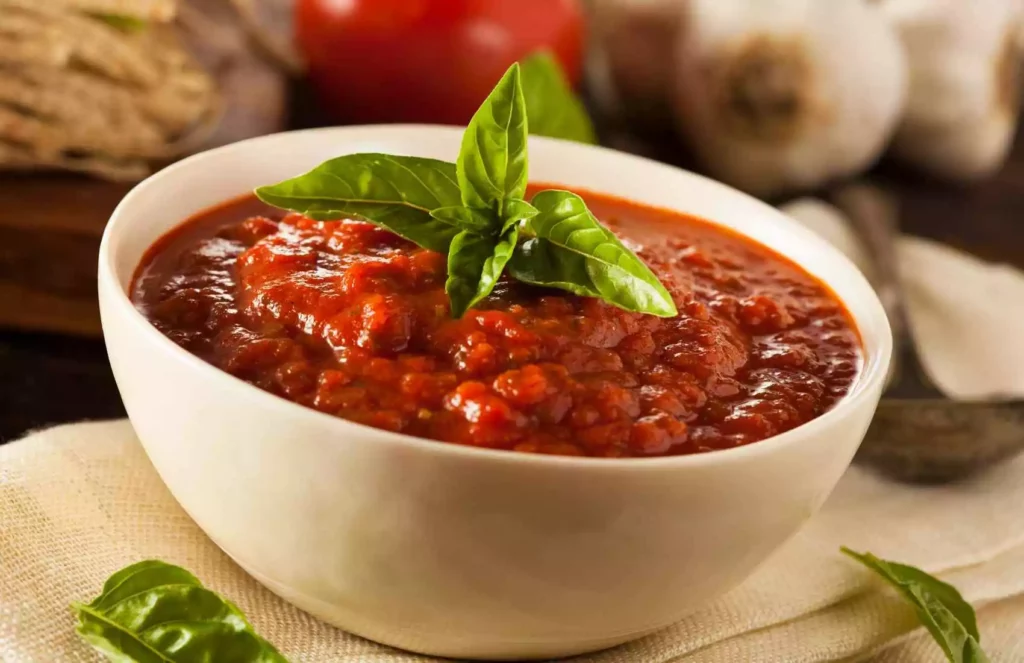Do you want to know the difference between red sauce vs marinara sauce?
We bet they seem identical to the untrained eye! Yet, the truth is they have distinct identities that differentiate one from the other.
This post will guide you through the differences between these two popular Italian sauces – Red Sauce and Marinara Sauce – and help you understand the key differences.
Red Sauce vs. Marinara: Quick Comparison Table
| Characteristic | Red Sauce | Marinara Sauce |
| Origin | Originated in Italy, with regional variations | Originated among seafarers in Naples, Italy |
| Consistency | Thicker | Thinner |
| Flavor | Richer, more complex | Brighter, more tomato-forward |
| Cooking time | Longer, depending on specific red sauce recipe | Shorter—30 minutes only |
| Ingredients | Usually include vegetables, meat, dairy, and other ingredients | Usually, just tomatoes, herbs, seasoning, and spices |
| Versatility | Highly versatile, used as a base for many sauces | Less versatile, primarily used in its own form |
| Uses | Pizza, pasta, lasagna, eggplant Parmesan | Pasta, pizza, dipping sauce |
Red Sauce vs. Marinara: Origins and Ingredients
Before diving into the differences in detail, let’s briefly touch upon both sauces’ origins and primary ingredients.
Red Sauce

The term “red sauce” can refer to various sauces, but it’s most commonly used to describe a tomato-based sauce used in Italian-American cuisine. The red sauce can be made with various ingredients but typically includes tomatoes, garlic, herbs, and onions.
It can be used as a base for various dishes like spaghetti, lasagna, and eggplant parmesan.
In the United States, red sauce is often used as a catch-all term for any type of tomato-based sauce. However, in Italy, the term “red sauce” is more specific and refers to a particular type of sauce made with tomatoes, garlic, oregano, and basil. This type of sauce is known as “marinara sauce” in Italy.
Here are some of the most common types of Italian red sauce:
- Marinara sauce is the most basic type of red sauce made with tomatoes, garlic, oregano, and basil.
- Vodka sauce is made with marinara, vodka, and cream.
- Arrabbiata sauce is made with tomatoes, garlic, chili peppers, and olive oil.
- Amatriciana sauce has tomatoes, guanciale, and Pecorino Romano cheese.
Red sauce is a versatile ingredient that can be used in various dishes. It’s a staple in Italian-American cuisine but also popular in other cuisines worldwide.
Marinara Sauce

The term “marinara” derives from the word “mariner’s,” pointing to its origin among the seafarers of Naples in the 16th century. It’s believed that marinara sauce was originally created by sailors who needed a quick and easy way to make a flavorful sauce. It’s a red sauce, though not every red sauce is marinara.
Marinara sauce is a simple yet flavorful tomato sauce that is typically made with tomatoes, extra virgin olive oil, chopped or minced garlic, onions, salt, oregano, and basil. It’s a staple in Italian-American cuisine and is often used as a base for pasta dishes, such as spaghetti and meatballs.
Key Differences Between Red Sauce and Marinara Sauce
Now, let’s discuss the main differences between these two sauces. They lie primarily in the cooking method, flavor profile, and versatility.
Cooking Method
The primary difference between red sauce and marinara sauce is their preparation and cooking time.
Red sauces often require a prolonged simmering to develop a deeper flavor profile. This slow-cooked method blends all the ingredients harmoniously and provides a more complex taste.
On the other hand, Marinara sauce is typically prepared quickly. Tomatoes are simmered for a shorter time to maintain the freshness of the tomatoes, yet the chunks are grounded to give them a velvety texture. This cooking method highlights the brightness and sweetness of the tomatoes, making the sauce vibrant and tangy.
Flavor Profile
The slow simmering process of red sauce yields a rich, hearty, and robust flavor. It’s perfect for dishes that require a more robust, full-bodied sauce, such as lasagna or baked ziti.
Due to its quick cooking time, Marinara sauce maintains a light, fresh, and slightly acidic flavor profile. This characteristic makes it the perfect companion for dishes like seafood pasta, pizza, and simple spaghetti marinara.
Versatility
Given its robust and hearty nature, red sauce is more versatile and can be used as a base for many other sauces. For example, adding meat transforms it into a Bolognese, and cream yields a Vodka sauce.
While less versatile, Marinara sauce has a definitive place in Italian and Italian-American cuisine. Its simplicity allows the dish’s main ingredients to shine without overpowering them.
Hence,
While both red sauce and marinara sauce play significant roles in Italian cuisine, they have distinct identities. The strong red sauce is perfect for dishes requiring a rich, slow-cooked flavor, while the light and tangy marinara sauce complements dishes that need a fresh, tomato-centric taste.
So, whether you choose red sauce or marinara sauce will depend on the dish you are preparing and your desired flavor profile. Both sauces are delightful in their own ways, carrying centuries of Italian culinary tradition.







